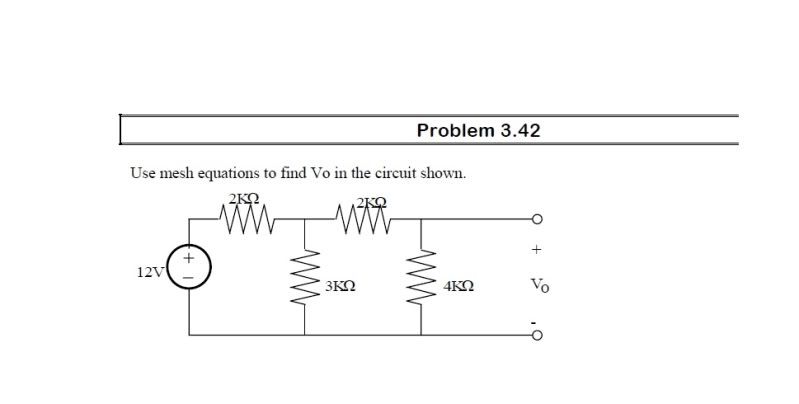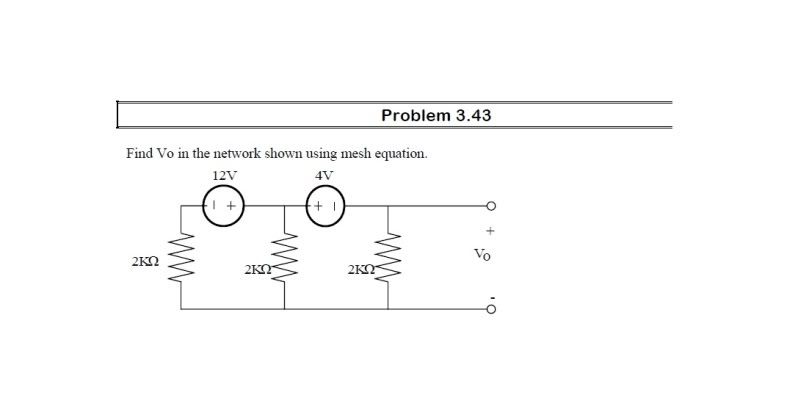 |
 |
 |
 |

|


|
|
|
|
|
|
#1
|
||||
|
||||
|
more circuit analysis questions
So I am stuck on a type of problem for my circuit analysis work. I cannot figure out how to solve.
 I need to use mesh/loop analysis to solve for Vo. I know I need to use KVL for each loop but I don't understand how to solve. The algebra is confusing me. It's not like normal math. help please! |
|
#2
|
|||
|
|||
|
39.6 Volts
I learned my basic electricity over 40 years ago and don't remember hearing the term mesh/loop analysis. Naming the reistors R1 through R4 left to right, start by solving for the voltage at the junction to the right of R1. This will be R2 in parallel with R3/R4 in series. R3 + R4 = 6K. These are in parallel with R2, so product over the sum = 3K X 6K / 3K + 6K = 2K. 2K in series with 2K splits the voltage in half for .5 X 120 or 60 Volts at the junction above R2. Then solve for the voltage split between R3 and R4 is simple by looking at it. .66 X the 60 Volts applied is 39.6 Volts. Since I spent the last 25 years or so in software without ever soldering a circuit during that time, I surprised myself.
__________________
2001 SLK 320 six speed manual 2014 Porsche Cayenne six speed manual Annoy a Liberal, Read the Constitution |
|
#3
|
||||
|
||||
|
I think I figured it out.....
For I1 I have : 2KI1 + 3K(I1-I2) = 12v for I2 I have : 4KI1 + 2KI2 + 3K(I1-I2) = 0 Then from there I believe I will have to simplify and solve. I1 : 2KI1 + 3KI1 - 3KI2 = 12 reduces to 5K1 - 3K2 = 12 I2 : 3KI1 - 3KI2 = 0 then I2: -3k2 = -3K1 reduced to I2 = 1/1000 or 1/k amps then using Ohms law take I2 multiply the 4K resistor on the right to get the voltage across it and it will be the same as Vo, which is 4V. |
|
#4
|
||||
|
||||
|
How about this one?
 I cannot seem to get I2 to equal something useful. |
|
#5
|
|||
|
|||
|
Quote:
This likes the long way around if you're solving for voltage. I just saw that I was working on 120V input rather than 12V so divide my answer by 10. Solving for currents is not necessary when they answer is looking for voltage. All you have to do is solve for voltage drops. I have to run right now, so I'll look at the other one later.
__________________
2001 SLK 320 six speed manual 2014 Porsche Cayenne six speed manual Annoy a Liberal, Read the Constitution |
|
#6
|
||||
|
||||
|
That was the way we were instructed to use. Thanks for your help. Cant wait to see how the second problem is done.
|
|
#7
|
|||
|
|||
|
This one is tougher. Can you provide an example of the "mesh" equation they cite? Without a few hints, I'm way to rusty to knock this one out quickly.
__________________
2001 SLK 320 six speed manual 2014 Porsche Cayenne six speed manual Annoy a Liberal, Read the Constitution |
|
#8
|
||||
|
||||
|
you could probably do it that way, but we need to do it via mesh/loop analysis
The answer in the book said 4 volts. Not 3.6v |
|
#9
|
|||
|
|||
|
Quote:
I'm not sure which one you're talking about now, but when I blew through and calculated using 120V I got 39.6, which with a 12V source ends up being 3.96 or very close to four volts. It's been close to 40 years since I took EE classes and even longer since basic electricity and basic electronics. For the life of me I don't remember a "mesh" equation. At my age, however, there are some days I feel lucky to remember how to find my way to the refrigerator.
__________________
2001 SLK 320 six speed manual 2014 Porsche Cayenne six speed manual Annoy a Liberal, Read the Constitution |
|
#10
|
||||
|
||||
|
#11
|
|||
|
|||
|
It's the multiple polar opposite voltage sources that are throwing me. Kirchoffs Law I remember, but I'm pretty unpracticed and the sources are killing me.
__________________
2001 SLK 320 six speed manual 2014 Porsche Cayenne six speed manual Annoy a Liberal, Read the Constitution |
|
#12
|
||||
|
||||
|
I'm lost at how to solve lol.
I think I have the passive sign convention thing down. I1 : 2KI1 - 12v + 2K(I1 - I2) = 0 reduces to 4KI1 - 2KI2 = 12v I2 : -2K(I1-I2) + 2KI2 = -4v reduces to 4KI2 - 2KI1 = -4V and I'm not sure if I2 is correct. I think I have the passive sign convention correct. |
|
#13
|
|||
|
|||
|
I did this about 2 years ago. Yes it is a specific technique. There is a specific "recipe" for how to do it. As I recall you identify every circuit "loop" keeping in mind that some components are shared by more than one loop. You write an equation for each loop, keeping track of all your polarities which can be tricky. The you end up with simultaneous equations. I solved those with matrix algebra but you might get away with substitution. (yeah my teacher made us do the matrix by hand). But I double-checked with my TI-83. What book are you using?
__________________
1998 C230 330,000 miles (currently dead of second failed EIS, yours will fail too, turning you into the dealer's personal human cash machine) 1988 F150 144,000 miles (leaks all the colors of the rainbow) Previous stars: 1981 Brava 210,000 miles, 1978 128 150,000 miles, 1977 B200 Van 175,000 miles, 1972 Vega (great, if rusty, car), 1972 Celica, 1986.5 Supra |
|
#14
|
||||
|
||||
|
Brief introduction to circuit analysis by J. David Irwin.
I wish we did the matrix version, looks easier but I dont know how to do it(so its not easy?) |
|
#15
|
||||
|
||||
|
nothing? anyone?
|
 |
| Bookmarks |
|
|